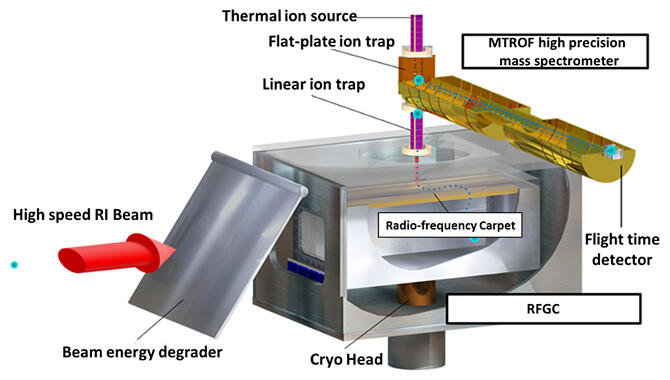A joint research group led by Michiharu Wada, Head of the Wako Nuclear Science Center, Institute of Particle and Nuclear Studies, High-energy Accelerator Research Organization (KEK), Marco Rosenbusch, Assistant Professor, and Shun Iimura, Junior Research Associate of the Slow RI Data Team, RIKEN Nishina Center for Accelerator-Based Science, used the Superconducting RI Beam Generator and Separator (BigRIPS), the Slow RI Beam Generator (SLOWRI) and the Multiple Reflectance Time-of-Flight (MRTOF) mass spectrometer at the RI beam factory (RIBF) heavy-ion accelerator facility at RIKEN, and succeeded in highly accurate measurements of the masses of neutron-rich vanadium and titanium isotopes. This led to the discovery that the 'new magic number' of 34 neutrons is nonexistent in titanium and vanadium isotopes.
The group measured their masses by decelerating and cooling fast 'cocktail beams' containing titanium isotopes (Ti-56, Ti-58) and vanadium isotopes (V-55-59) with the SLOWRI prototype system, which consists mainly of a radio-frequency gas cell. They were then collected in an ion trap and measured by MRTOF for mass. In the measurement of Ti-58, they were able to determine the atomic mass of −58Ti with high accuracy and precision from the ratio between the time of flight of the −58TiOH+ ion and the simultaneously measured C2FO2+ molecular ion. At the same time, they could measure the masses of Cr-58, V-58 and V-59.

The RI beam is decelerated by an energy degrader plate and then stopped in a radio-frequency gas cell (RFGC) system filled with helium gas at 0.2 atm, where it is extracted by a radio-frequency carpet and collected in an ion trap. The trapped ions are injected into the MRTOF mass spectrometer and, after several hundred round trips through it, are launched into the detector, where their time of flight is recorded.
Provided by KEK
This way allowed them to successfully measure the masses of 15 isotopes of Sc (scandium), Ti, V, Cr (chromium) and Mn (manganese). The researchers found good agreement for nuclides reported with high accuracy in literature values, and achieved much better accuracy for Sc-55, Ti-56, Ti-58, V-56, V-58 and V-59.
As a result of deriving the two-neutron shell gap energy (Δ2n) using this mass measurement result, the new mass values of Ti-58 and V-59 are much smaller than the literature values, and since Δ2n, the magic number index, is equivalent to Sc and Cr, it indicated that the new magic number N=34, which has been suggested so far, is nonexistent in titanium and vanadium. This result is supported by the latest theory (Monte Carlo shell model), newly calculated on the Fugaku supercomputer.
"The titanium and vanadium isotopes successfully measured this time were nuclei that had been measured by other methods in the past, but we were able to determine their masses with much higher precision, which is a ground-breaking achievement that overturns conventional wisdom," explained Wada. "Moving forward, we would like to carry out exhaustive high-precision mass measurements of more than a thousand measurable nuclei, with the aim of making discoveries that overturn conventional wisdom, as well as revealing the origin of heavier elements."
This article has been translated by JST with permission from The Science News Ltd. (https://sci-news.co.jp/). Unauthorized reproduction of the article and photographs is prohibited.




